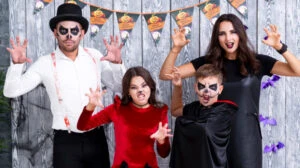
Halloween—the word conjures up exciting memories for most people, and both children and adults often rate it as one of their favorite days of the year. However, it is also one of the four most likely days of the year that children will make trips to the emergency room.[1] Injuries vary across a wide spectrum in both children and adults, from trip and fall incidents, motor vehicle accidents, to unforeseen consequences of ill-fitting costumes, it’s no surprise that Halloween, although a day filled with fun and excitement, is often considered one of the most dangerous days of the year. Here are some of the common ways people are injured on Halloween, and tips for how you can keep yourself safe this year.
1. Traffic Accidents
The U.S. Census Bureau estimates that approximately 40 million kids participate in the annual tradition of trick-or-treating on Halloween.[2] The sheer number of participants contributes to the increased incident in injury, especially in the streets. On this night, there is an increased risk for both pedestrian accidents and drunk driving collisions. Parents should make sure their children keep on the sidewalks and avoid dangerous intersections. Accompany your children while they are out trick-or-treating and be sure to give them flashlights so oncoming cars can easily see them. If you’re attending an adult party, make plans to stay overnight or designate a driver ahead of time.

Injured on Someone Else’s Property?
Know Your RightsOur expert premises liability lawyers will help you hold negligent property owners accountable.
Get a Free Case Evaluation
504-500-11112. Eye Injuries
If you’re not careful, your Halloween costume could leave you with a permanent eye patch—even after the holiday is over. Many costumes for children (and adults) come with sharp objects like swords, canes, and sticks. These props contain sharp edges, and children may play with them as toys. To be safe, keep all sharp props away from children and stick to softer accessories made of foam and rubber. If attending a crowded party, consider leaving your props at home, or at least cover or remove any sharp edges.
Adults may be victims of eye injuries on Halloween as well. A common trend seen lately in adult costumes is the use of decorative contact lenses. Decorative contact lenses are “medical devices” which must be approved by the U.S. Food and Drug Administration. Approved products must meet mandatory performance standards for toxicology and have an engineering design that has been shown to be safe. However, the majority of these products are not approved and are readily available online, in beauty stores, in mall kiosks, and elsewhere.[3] Adverse events that have been reported range from irritated red eyes to abrasions and serious infections. So if you plan to wear decorative contact lenses as part of your costume, you may want to think twice, or at least double-check that you’re using a trusted brand.
3. Burn Injuries
Many Halloween costumes come with oversized sleeves, long capes, and wigs. These costumes pose a serious risk when exposed to open flames, such as a candle in a Jack-o-Lantern. Parents should make sure to buy fire retardant costumes for their children or consider using battery-powered candles for a safer source of light.
Harmed by a Dangerous Defective Product?
We’re Here for YouOur experienced product liability attorneys will fight to secure the compensation you deserve for your injuries.
Schedule a Free Consultation
504-500-11114. Poisoning Incidents
Although it doesn’t happen often, you still hear stories about poisoned Halloween candy. In reality, there have only been a few confirmed cases of Halloween poisoning in people, but in an abundance of caution, parents should sort through candy with their kids and throw out any partially unwrapped or suspicious-looking candy.
The real poisoning that you should be concerned about on Halloween is in your pets. Chocolate is one of the most problematic candies for dogs and cats, as they do not metabolize it as well as people. The most common food-related hazards on Halloween for pets include poisoning from chocolate, raisins, candy wrappers, or just candy overindulgence in general. Be sure to store your Halloween candy in a place where your pets can’t reach it to avoid these complications.
Slip and Fall Accident?
Get the Legal Support You NeedOur dedicated slip and fall attorneys will help you navigate the legal process and claim the compensation you deserve.
Speak to a Lawyer Today
504-500-11115. Home Injuries
Speaking of dogs—our last tip is to take steps to protect trick-or-treaters around your home. Keep your animals under control when opening doors to trick-or-treaters. The constant ringing of the doorbell is enough to set most dogs off—but couple that with the desire to protect owners from the strangely-dressed creatures at the door, with a highly protective dog you may be looking at an accident waiting to happen. Louisiana has a heightened standard for dog bites than most other states. Regardless of the dog’s bite history or outward manifestations of aggression, an owner is liable for any injuries caused by their dog—even if the dog was provoked! To play it safe, keep your dog in a crate or locked in another room during peak trick-or-treating hours.
In addition to keeping your pets under control, you will want to make sure the entire premise of your home is safe. Whether or not you intend on inviting trick-or-treaters to your door, you should prepare for them to be out and about in your neighborhood and potentially walking along your property. Repair any known dangers on your property, make a reasonable inspection to discover any potentially unknown dangers, and correct those hazards as well. You can make your home safer for trick-or-treaters by making sure the area around your home is well lit, removing any potential obstacles, such as loose bricks, toys, and water hoses, and putting up clear warning signs around obstacles that you can’t fix.
While Halloween brings a lot of excitement into your household, it’s also important to remember safety. Halloween injuries, unfortunately, happen every year. By knowing these common causes of injury, you will be better equipped to prevent them.
In the event a Halloween injury does happen to you, contact us to help you address your potential claim and injuries at (504) 500-1111.
[1] D’Ippolito A, Collins CL, Comstock RD. Epidemiology of pediatric holiday-related injuries presenting to US emergency departments. Pediatrics. 2010;125:931-937.
[2] US Department of Health and Human Services. Number of U.S. Kids Injured on Halloween Is Scary. 2011.
[3] Scudder, Laurie, DNP, NP. True Halloween Frights: What Clinicians Need to Know. Mescape (Oct. 22, 2018). https://www.medscape.com/features/slideshow/halloween#7.


